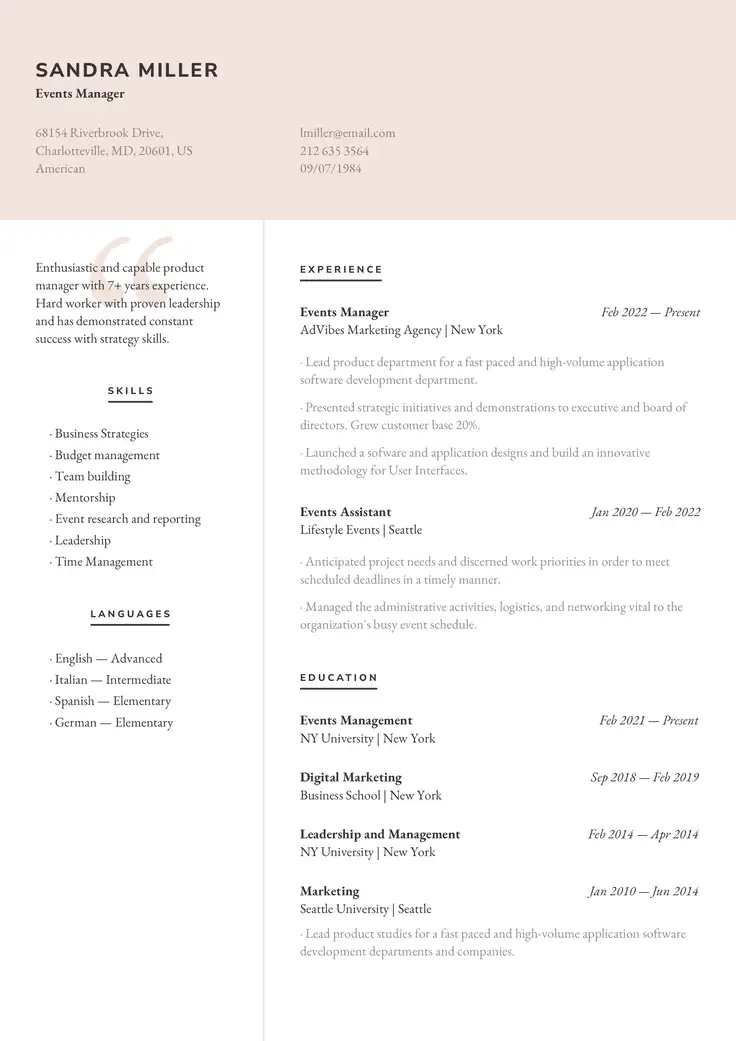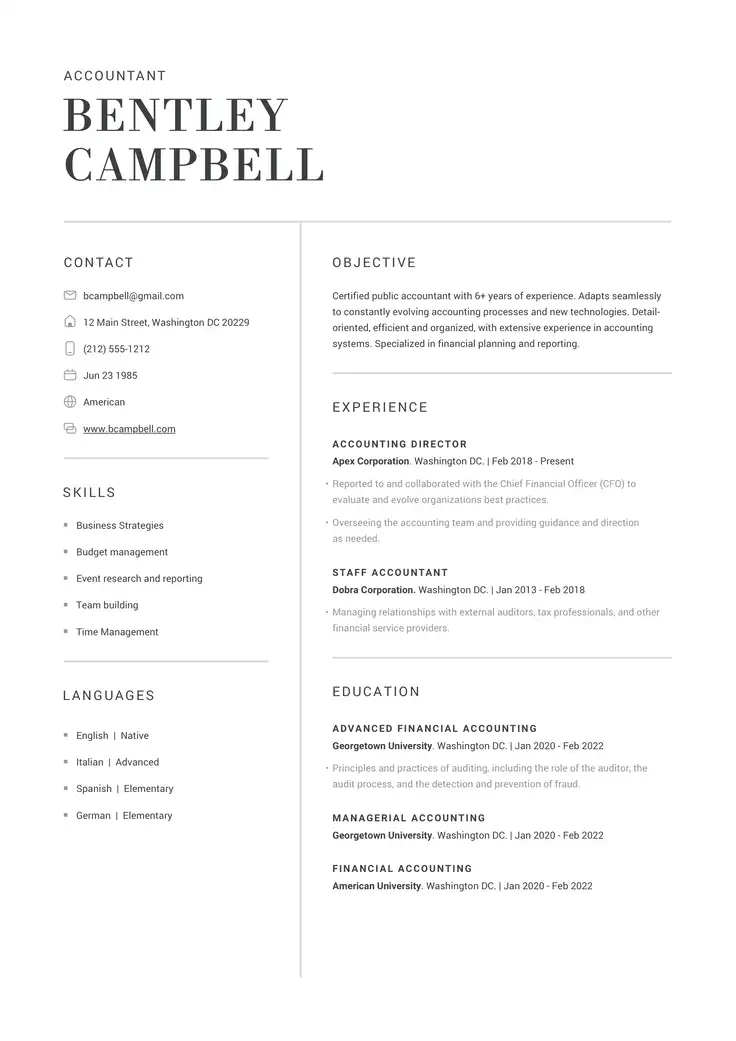Chronological Resume Writing Guide
Get the best out of the standard resume format

The most typical resume format and the one that best shows off your professional accomplishments is a chronological resume.
With a chronological resume format, you can highlight your work history, achievements, and roles in past jobs, especially if you’re an experienced job seeker.
In this guide, you’ll learn how to craft a chronological resume, what to include, and get expert advice. Along with these tips, you can also use our AI resume builder and samples to help yourself craft a stunning application.
What is a Chronological Resume?
A Chronological Resume is a popular format that allows you to list your work history from your most recent job to your earliest.
Experience is one of the most important aspects of your resume that recruiters will evaluate for a number of reasons. One study states that 88% of hiring managers say that work experience is the most important section of the resume.
It is a favorite of HR specialists because it clearly displays your past jobs in a clear order, so that they can better understand your:
- Professional achievements
- Quantifiable results
- Commitment
- Hard and soft skills
A chronological format starts with a summary, then lists jobs in reverse order, professional organization memberships, certifications/trainings, and ends with your education.
You can also add sections like skills or volunteer work if they fit the job you’re applying for.
Chronological Resume Example
Below is a sample chronological resume that demonstrates how to structure your experience, skills, and education in reverse chronological order.
Jordan Taylor
Los Angeles, CA | jordan.taylor@email.com | (555) 123-4567
Professional Summary
Results-driven marketing specialist with 6+ years of experience in digital campaign management, brand strategy, and lead generation. Proven ability to boost online engagement and drive ROI through data-led initiatives.
Professional Experience
Senior Marketing Specialist
BrightEdge Solutions – Los Angeles, CA
Jan 2021 – Present
- Increased email campaign open rates by 38% through A/B testing and segmentation
- Led cross-functional team to launch new product line, contributing to a 22% revenue boost
- Managed $250K quarterly ad budget across Google, LinkedIn, and Meta platforms
Marketing Coordinator
Nimbus Creative – Santa Monica, CA
Jun 2017 – Dec 2020
- Developed and managed content calendars across 5+ social channels
- Collaborated with design and product teams on rebranding initiative, improving brand consistency
- Tracked KPIs to optimize PPC campaigns, lowering cost-per-click by 18%
Education
Bachelor of Arts in Communications
West Coast University – Los Angeles, CA
Graduated: 2017
Skills
- Digital Marketing
- Google Ads
- SEO
- Project Management
- Adobe Creative Suite
Certifications
- Google Ads Search Certification – Google (2023)
- HubSpot Content Marketing Certification – HubSpot Academy (2022)
- Certified Digital Marketing Professional (CDMP) – Digital Marketing Institute (2021)
As you can see in this chronological resume format example, experience is listed after a summary with quantifiable data. Adding certifications is also a nice way to give a hiring manager more confidence that you’re the right person for the job.
How To Write a Chronological Resume: Step-by-Step
To draft your own chronological resume, there are a number of steps you should follow to make sure you include all the necessary information in a logical order.
Follow these steps to make your previous accomplishments and experience stand out to hiring managers:
- Start with contact information: At the top, include your full name, phone number, email, LinkedIn (optional), and location (city, state).
- Write a captivating professional summary: Write a 2-3 line summary to highlight your experience, key strengths, and career goals tailored to the role.
- List work experience: Add your work experience, focusing on your most recent and relevant roles first. The work experience section is where jobseekers need to include quantifiable achievements instead of generic job tasks.
- Include a job title: Include the company name and location of where you previously worked.
- Add dates of past employment : Add 3-6 bullet points showing off your past accomplishments and KPIs (not just tasks). Be as accurate as possible, as hiring managers often verify employment dates.
- Add education: List your most recent degree, school name, and graduation year (This is optional if you have 5+ years of experience).
- Include a skills section: Add a short list of skills relevant to the job description. Use our skills generator to get recommendations that satisfy Applicant Tracking Systems (ATS) in seconds.
- Optional sections: Consider adding certifications, languages, volunteer work, professional associations, awards and recognition, or relevant seminars to round out your qualifications.
Use consistent formatting (font size between 10-12 points), clear headings, and keep the layout clean and ATS-friendly. Times have changed, and now two-page resumes are favored more than those on one page.
With our AI resume builder, summary generator, and templates, creating a resume in this format can be done in no time.
Pros and Cons of the Chronological Resume
Let’s look at the benefits of using this type of resume format and some disadvantages. It’s great for those with a clear career path or deep expertise in a specific field, helping them move forward in that area.
Pros 👍
- Clearly lists responsibilities and achievements for each job.
- Easy for hiring managers to read and see your career path.
- A very clear format.
- It can be used for the Applicant Tracking Systems, which is currently used by 99% of Fortune 500 companies. Using a resume template can optimize it for these systems more. Resumes can sometimes even be rejected before reaching a hiring manager, emphasizing the importance of ATS compatibility.
However, it may not be the best depending on your level of experience and work history.
Cons 👎
- Not the best format for those with gaps or regular job changes.
- This resume format could reveal your age and could create age-related discrimination.
- It’s a common format, so it might not stand out or showcase personality.
- It may not highlight your skills as much as you may like.
In cases like these, using other types of resume formats such as the functional or combination resume is better.
Tips for Writing the Chronological Resume
Making a chronological resume can raise certain questions, such as what do I need to include in the work experience section?
The following tips will serve as guidelines for learning how to create a resume with the typical chronological resume format.
- Use action verbs, statistics, and facts to back up your claims. For example, “Increased social media engagement by 150% and grew follower base from 5,000 to 10,000 within six months through targeted content strategy.”
- Always maintain a formal tone and structured layout.
- Choose professional fonts like Arial, Calibri, or Times New Roman in 10-12 point size for optimal readability.
- Check for errors to ensure a good final product. A resume writer can assist you in creating an error-free final resume.
- Different layouts exist for students and other individuals.
💡Tip
Make sure the best parts of your experience stand out by using AI-powered suggestions that you can create with our resume builder.
Consider trying out a number of templates to find which one goes best with your resume.
Key Takeaways
To make sure that your chronological resume is impactful, keep in mind the tips mentioned in this article, such as:
- Include quantifiable data in your experience section.
- Add certifications as further proof of your qualifications.
- Use action verbs and a formal tone when writing your resume.
With our AI resume editing tools and these tips, you’ll be able to show any hiring manager that you’re ready for any role that you plan to apply for.
FAQs
The difference between a functional resume and chronological resume is that the functional format highlights skills and achievements at the top.
A chronological resume, on the other hand, lists work experience in reverse date order, putting more emphasis on career progression. Traditionally, the skills section often appears toward the end of the document, but nowadays it is acceptable to list your skills directly under the resume summary.
Functional resumes are better for career changers or those with gaps, while chronological resumes are ideal for steady work histories. Work history is de-emphasized, often appearing as a brief list near the bottom. Employment dates may be minimized or excluded entirely.
If you are someone with significant employment gaps, frequent job changes, or limited relevant experience, you may want to avoid a chronological resume.
As this format places a spotlight on dates and job continuity, it could raise red flags. Instead, try a functional or combination resume to better highlight your skills over your lack of experience.
Yes, you can mix functional and chronological resume formats. This type of format is called a combination or hybrid resume.
It starts with a skills summary, followed by a reverse-chronological work history. It’s best for anyone who wants to highlight transferable skills while still showing consistent work experience. A combination or hybrid resume allows you to address multiple audiences. It appeals to both ATS systems and recruiters.

